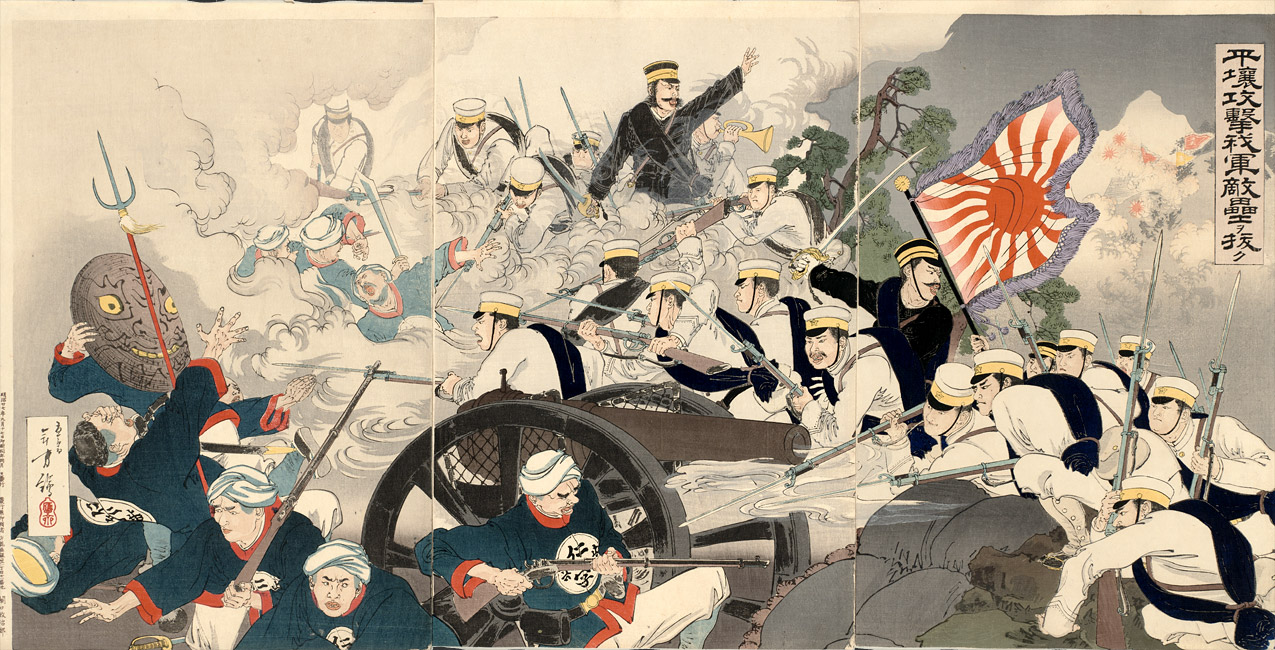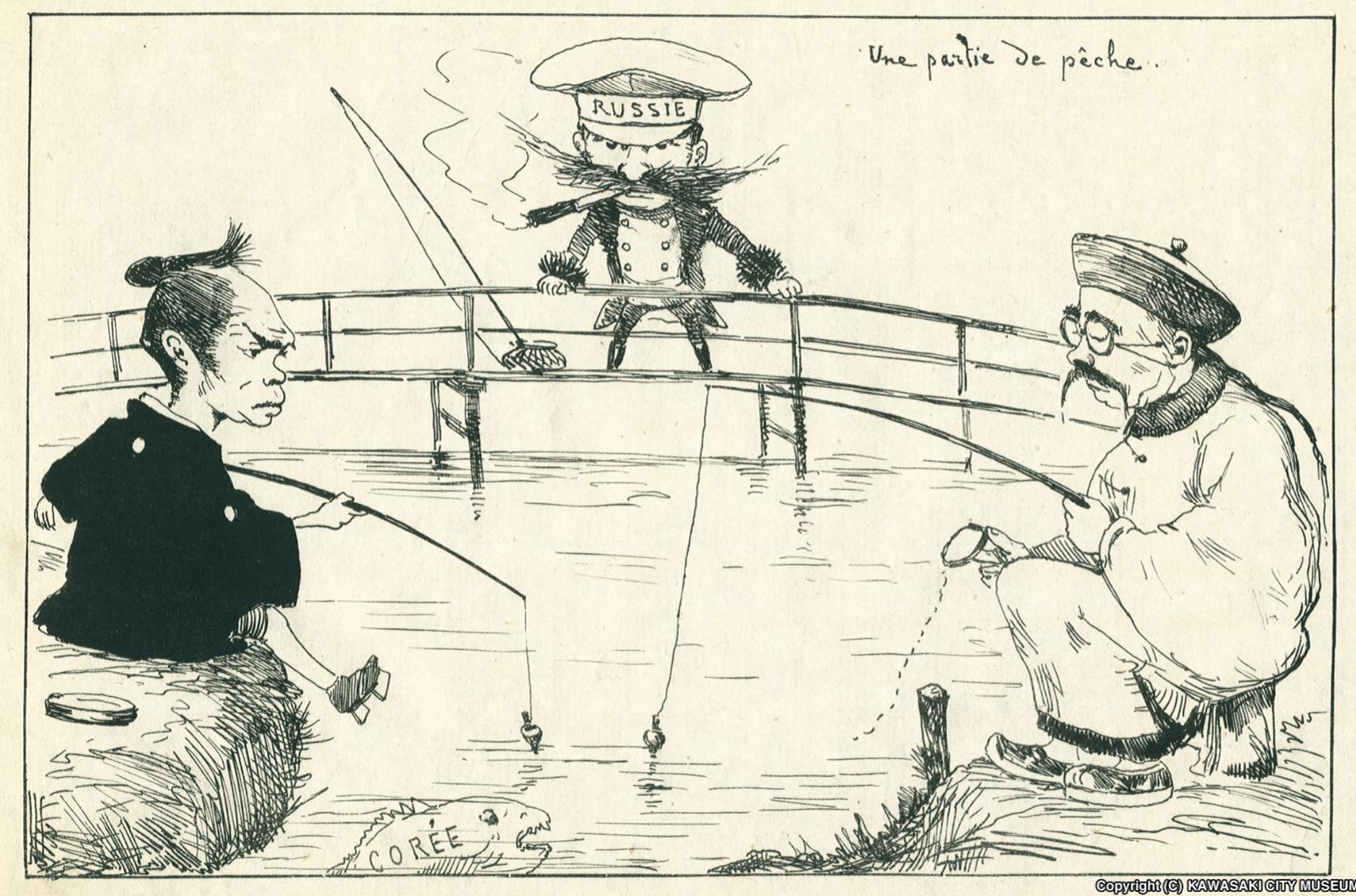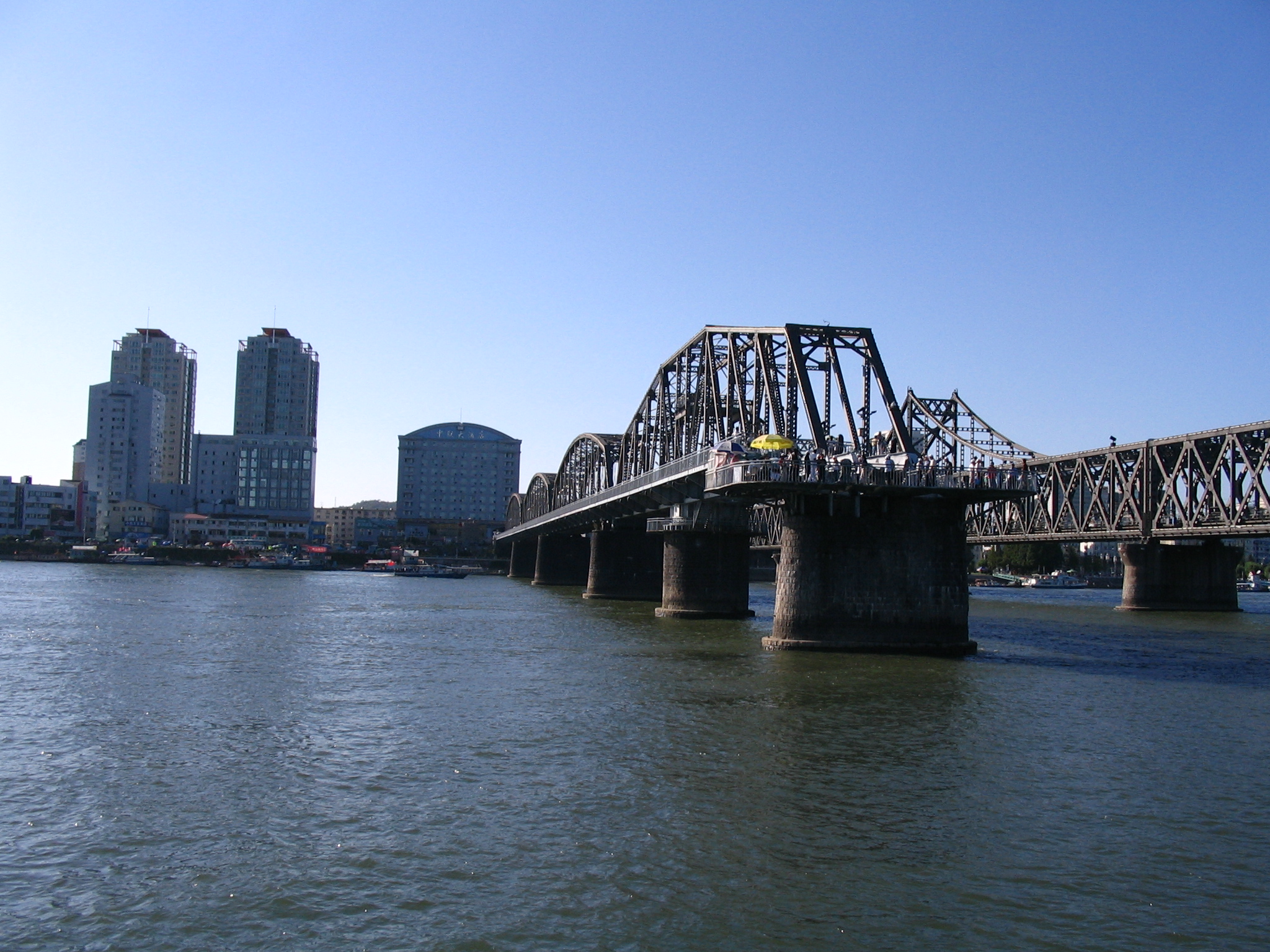|
Battle Of Pyongyang (1894)
The Battle of Pyongyang (; zh, 平壤之戰) was the second major land battle of the First Sino-Japanese War. It took place on 15 September 1894 in Pyongyang, Korea between the forces of Meiji government, Meiji Japan and Qing dynasty, Qing China. It is sometimes referred to archaically in Western sources as the "Battle of Ping-yang". About 20,000 Chinese troops of the Huai Army under overall command of General Ye Zhichao had arrived in Pyongyang on 4 August 1894. They had made extensive repairs to its ancient city walls, feeling itself secure in its superior numbers and in the strength of the defenses. The Huai Army had China's best troops, and they were equipped with modern weaponry, including Mauser breechloader rifles, Krupp artillery pieces, and a large quantity of ammunition. The Chinese military command intended that Pyongyang would be their headquarters in Korea. Prince Yamagata Aritomo's First Army (Japan), First Army, of the Imperial Japanese Army, converged on Pyo ... [...More Info...] [...Related Items...] OR: [Wikipedia] [Google] [Baidu] |
First Sino-Japanese War
The First Sino-Japanese War (25 July 189417 April 1895), or the First China–Japan War, was a conflict between the Qing dynasty of China and the Empire of Japan primarily over influence in Joseon, Korea. In Chinese it is commonly known as the Jiawu War. After more than six months of unbroken successes by Japanese land and naval forces and the loss of the ports of Lüshunkou (Port Arthur) and Weihaiwei, the Qing government sued for peace in February 1895 and signed the Unequal treaties, unequal Treaty of Shimonoseki two months later, ending the war. In the late 19th century, Korea remained one of China's tributary states, while Japan viewed it as a target of imperial expansion. In June 1894, the Qing government, at the request of the Korean emperor Gojong of Korea, Gojong, sent 2,800 troops to aid in suppressing the Donghak Peasant Revolution. The Japanese considered this a violation of the 1885 Convention of Tientsin, and sent an expeditionary force of 8,000 troops, which la ... [...More Info...] [...Related Items...] OR: [Wikipedia] [Google] [Baidu] |
China
China, officially the People's Republic of China (PRC), is a country in East Asia. With population of China, a population exceeding 1.4 billion, it is the list of countries by population (United Nations), second-most populous country after India, representing 17.4% of the world population. China spans the equivalent of five time zones and Borders of China, borders fourteen countries by land across an area of nearly , making it the list of countries and dependencies by area, third-largest country by land area. The country is divided into 33 Province-level divisions of China, province-level divisions: 22 provinces of China, provinces, 5 autonomous regions of China, autonomous regions, 4 direct-administered municipalities of China, municipalities, and 2 semi-autonomous special administrative regions. Beijing is the country's capital, while Shanghai is List of cities in China by population, its most populous city by urban area and largest financial center. Considered one of six ... [...More Info...] [...Related Items...] OR: [Wikipedia] [Google] [Baidu] |
Wonsan
Wonsan (), previously known as Wonsanjin (), is a port city and naval base located in Kangwon Province (North Korea), Kangwon Province, North Korea, along the eastern side of the Korean Peninsula, on the Sea of Japan and the provincial capital. The port was opened by Imperial Japanese Army, Japanese forces in 1880. Before the 19501953 Korean War, it fell within the jurisdiction of the then South Hamgyong Province, South Hamgyong province, and during the war, it was the location of the Blockade of Wonsan. The population of the city was estimated at 329,207 in 2013. Notable people from Wonsan include Kim Ki-nam (politician), Kim Ki-nam, a diplomat and former Vice Chairman of the ruling Workers' Party of Korea. In 2013, it was announced that Wonsan would be converted into a summer destination with resorts and entertainment. Having spent his childhood years there, Kim Jong Un has expressed significant interest in developing the region, with the construction of new infrastructure such ... [...More Info...] [...Related Items...] OR: [Wikipedia] [Google] [Baidu] |
Pusan
Busan (), officially Busan Metropolitan City, is South Korea's second most populous city after Seoul, with a population of over 3.3 million as of 2024. Formerly romanized as Pusan, it is the economic, cultural and educational center of southeastern South Korea, with its port being South Korea's busiest and the sixth-busiest in the world. The surrounding "Southeastern Maritime Industrial Region" (including Ulsan, South Gyeongsang, Daegu, and part of North Gyeongsang and South Jeolla) is South Korea's largest industrial area. The large volumes of port traffic and urban population in excess of 1 million make Busan a Large-Port metropolis using the Southampton System of Port-City classification. As of 2019, Busan Port is the primary port in Korea and the world's sixth-largest container port. Busan is divided into 15 major administrative districts and a single county, together housing a population of approximately 3.6 million. The full metropolitan area, the Southeastern Mari ... [...More Info...] [...Related Items...] OR: [Wikipedia] [Google] [Baidu] |
Chemulpo
Incheon is a city located in northwestern South Korea, bordering Seoul and Gyeonggi Province to the east. Inhabited since the Neolithic, Incheon was home to just 4,700 people when it became an international port in 1883. As of February 2020, about 3 million people live in the city, making it South Korea's third-most-populous city after Seoul and Busan. The city's growth has been assured in modern times with the development of its port due to its natural advantages as a coastal city and its proximity to the South Korean capital. It is part of the Seoul Metropolitan Area, along with Seoul itself and Gyeonggi Province, forming the world's fourth-largest metropolitan area by population. Incheon has since led the economic development of South Korea by opening its port to the outside world, ushering in the modernization of South Korea as a center of industrialization. In 2003, the city was designated as South Korea's first free economic zone. Since then, large local companies a ... [...More Info...] [...Related Items...] OR: [Wikipedia] [Google] [Baidu] |
Seoul
Seoul, officially Seoul Special Metropolitan City, is the capital city, capital and largest city of South Korea. The broader Seoul Metropolitan Area, encompassing Seoul, Gyeonggi Province and Incheon, emerged as the world's List of cities by GDP, sixth largest metropolitan economy in 2022, trailing behind New York metropolitan area, New York, Greater Tokyo Area, Tokyo, Greater Los Angeles, Los Angeles, Paris metropolitan area, Paris, and London metropolitan area, London, and hosts more than half of South Korea's population. Although Seoul's population peaked at over 10 million, it has gradually decreased since 2014, standing at about 9.6 million residents as of 2024. Seoul is the seat of the Government of South Korea, South Korean government. Seoul's history traces back to 18 BC when it was founded by the people of Baekje, one of the Three Kingdoms of Korea. During the Joseon dynasty, Seoul was officially designated as the capital, surrounded by the Fortress Wall of Seoul. I ... [...More Info...] [...Related Items...] OR: [Wikipedia] [Google] [Baidu] |
Taedong River
The Taedong River () is a large river in North Korea. The river rises in the Rangrim Mountains of the country's north where it then flows southwest into Korea Bay at Namp'o.Suh, Dae-Sook (1987) "North Korea in 1986: Strengthening the Soviet Connection" ''Asian Survey'' 27(1): pp. 56-63, page 62 In between, it runs through the country's capital, Pyongyang. Along the river are landmarks such as the Juche Tower and Kim Il-sung Square. The river is in length, and is generally deep. It is the fifth-longest river on the Korean peninsula and the second-longest in North Korea. Pyongyang is approximately 110 km upstream from the mouth, Sunchon 192 km upstream, and Taehŭng 414 km upstream. Because of its depth, it is widely used for river transport; it is navigable by large ships up to 65 km inland, although most commercial traffic stops at Songrim. History The kingdom of Koguryo was founded on its shores. Many archeological sites dating to the Neolithic and ... [...More Info...] [...Related Items...] OR: [Wikipedia] [Google] [Baidu] |
Battle Of Seonghwan
The Battle of Seonghwan () was the first major land battle of the First Sino-Japanese War. It took place on 29 July 1894 at the hamlet of Seonghwan, outside of Cheonan, Chungcheongnam-do Korea between the forces of Meiji Japan and Qing China. It is also referred to as the Battle of Asan (Japanese: 牙山作戦 ). Background Following the capture of the Royal Palace at Seoul and disarmament of the Korean troops, the Japanese began preparations for an attack against Chinese forces camped at Asan. On 25 July, charged with implementing the Imperial Japanese Army's commission from new Korean government to expel the Chinese Beiyang Army from Korean territory by force, a detachment of the Japanese First Army consisting of 4,000 men and four artillery pieces under command of Major General Ōshima Yoshimasa marched south from Seoul towards the major port city of Asan. The Chinese forces stationed near Seonghwan numbered about 3,880 men under General Ye Zhichao, and had anticipated t ... [...More Info...] [...Related Items...] OR: [Wikipedia] [Google] [Baidu] |
Green Standard Army
The Green Standard Army (; ) was the name of a category of military units under the control of Qing dynasty in China. It was made up mostly of ethnic Han soldiers and operated concurrently with the Manchu-Mongol- Han Eight Banner armies. In areas with a high concentration of Hui people, Muslims served as soldiers in the Green Standard Army. After the Qing consolidated control over China, the Green Standard Army was primarily used as a police force. Despite its name, the Green Standard Army served as a gendarmerie rather than a military force. After the formation of "brave battalions" in response to the mid-19th century rebellions in China, who were mercenaries hired and financed by provincial governors, the Green Standard were relegated for local security only, while the braves became the Qing dynasty's rapid response force. There was an effort starting in the 1860s to modernize Green Standard units to make them similar to the braves, and the Late Qing reforms in the early 1900s ... [...More Info...] [...Related Items...] OR: [Wikipedia] [Google] [Baidu] |
China–North Korea Border
The China–North Korea border is an Border, international border separating China and North Korea, extending from Korea Bay in the west to a China–North Korea–Russia tripoint, tripoint with Russia in the east. The total length of the border is 1,352 kilometers (840 mi). The current border was created by Sino–North Korean Border Treaty, two secret treaties signed between China and North Korea in 1962 and 1964. Geography From west to east, the two countries are divided by three significant geographical features: the Yalu River, Paektu Mountain, and the Tumen River. Dandong, in the Liaoning Province of China, on the Yalu River delta, is the largest city on the border. On the other side of the river is the city of Sinuiju in North Pyongan Province, North Korea. The two cities are situated on the Yalu river delta at the western end of the border, near the Yellow Sea. Their waterfronts face each other and are connected by the Sino-Korean Friendship Bridge. There ar ... [...More Info...] [...Related Items...] OR: [Wikipedia] [Google] [Baidu] |
Imperial Japanese Army
The Imperial Japanese Army (IJA; , ''Dai-Nippon Teikoku Rikugun'', "Army of the Greater Japanese Empire") was the principal ground force of the Empire of Japan from 1871 to 1945. It played a central role in Japan’s rapid modernization during the Meiji period, fought in numerous conflicts including the First Sino-Japanese War, the Russo-Japanese War, World War I, the Second Sino-Japanese War, and World War II, and became a dominant force in Japanese politics. Initially formed from domain armies after the Meiji Restoration, it evolved into a powerful modern military influenced by French and German models. The IJA was responsible for several overseas military campaigns, including the invasion of Manchuria, involvement in the Boxer Rebellion, and fighting across the Asia-Pacific during the Pacific War. Notorious for committing widespread Japanese war crimes, war crimes, the army was dissolved after Japan's surrender in 1945, and its functions were succeeded by the Japan Ground Self-D ... [...More Info...] [...Related Items...] OR: [Wikipedia] [Google] [Baidu] |
First Army (Japan)
The was an army of the Imperial Japanese Army. It was raised and demobilized on three occasions. History The Japanese 1st Army was initially raised during the First Sino-Japanese War from 1 September 1894 – 28 May 1895 under the command of General Yamagata Aritomo. It participated in all of the major battles of that conflict, and was demobilized at the successful end of that war. It was revived for the Russo-Japanese War from 2 February 1904 – 9 December 1905 under the command of General Kuroki Tamemoto. Its forces were the first to land in Korea and Manchuria and it fought in most of the major campaigns of the war, including the Battle of Yalu River, Battle of Motien Pass, Battle of Liaoyang, Battle of Shaho, Battle of Sandepu, and Battle of Mukden. It was again demobilized at the end of that conflict. The Japanese 1st Army was raised again on 26 August 1937 in Tianjin, China under the Japanese China Garrison Army. In addition to protecting the Japanese settleme ... [...More Info...] [...Related Items...] OR: [Wikipedia] [Google] [Baidu] |







